- Average Rating:
- Not yet rated
- Topic Areas:
- Milton Erickson | Ericksonian Hypnosis and Therapy Techniques | Hypnotherapy | Phobia | Strategic Therapy | Hypnosis
- Bundle:
- Spanish Erickson Video Bundle
- Categories:
- Erickson Streaming Video Collection | Erickson Materials | Milton H. Erickson Collections | Spanish | World Languages
- Faculty:
- Jeffrey Zeig, PhD | Milton H. Erickson, MD
- Course Levels:
- Master Degree or Higher in Health-Related Field
- Duration:
- 1 Hour 12 Minutes
- Format:
- Audio and Video
- Original Program Date:
- Aug 13, 2020
- Short Description:
- Este video contiene la mejor ilustración de cómo Milton Erickson maneja los casos que se le presentan. Utilizando tanto la hipnoterapia como las directivas estratégicas, Erickson trabaja con una mujer que tiene fobia a volar en un avión. Este caso significativo ejemplifica los principios y prácticas fundamentales de un enfoque ericksoniano. Estos pueden aplicarse a otros problemas que se presenten y ser utilizados por los médicos que se suscriben a otras metodologías de tratamiento para un problema en particular.
- Price:
- $49.95 - Base Price
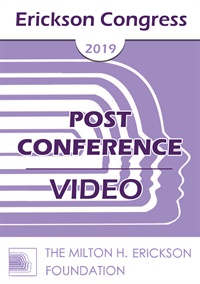
- Average Rating:
- Not yet rated
- Topic Areas:
- Master Classes | Ericksonian Psychotherapy | Psychotherapy | Brief Therapy | Hypnotherapy | Self-Relations | Utilization
- Categories:
- Erickson Congress | Erickson Congress 2019
- Faculty:
- Bill O'Hanlon, MS | Jeffrey Zeig, PhD
- Course Levels:
- Master Degree or Higher in Health-Related Field
- Duration:
- 4 Hours 49 Minutes
- Format:
- Audio and Video
- Original Program Date:
- Dec 16, 2019
- Short Description:
- Ericksonian hypnotherapy and the Self-Relations approach are experiential methods of change. In combination they can be synergistic. Psychotherapy is best when clients have a first-hand experience of an alive therapeutic process. Such dynamic empowering experiences pave the way for dynamic understandings. Bill O’Hanlon and Jeffrey Zeig will engage with each other and the participants to examine commonalities and differences in their work.
- Price:
- $59.00 - Base Price
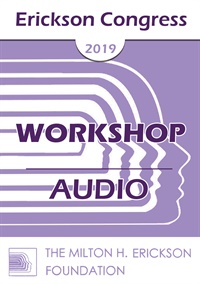
- Average Rating:
- Not yet rated
- Topic Areas:
- Workshops | Art and Creativity | Hypnosis | Hypnotherapy | Music
- Categories:
- Erickson Congress | Erickson Congress 2019
- Faculty:
- Norma Barretta, PhD | Jolie Barretta
- Duration:
- 1 Hour 55 Minutes
- Format:
- Audio Only
- Original Program Date:
- Dec 15, 2019
- Short Description:
- Hypnosis can interrupt dysfunctional loops, breaking negative patterns. With the skillful addition of sound that process is often speeded up and has a profound effect physiologically as well as psychologically, influencing and entraining the biological state of the subject. Participants will be shown how to enhance their awareness of tonality, volume, and the power inherent in vowel sounds. Using frequencies to deepen trance will be part of the group experience.
- Price:
- $15.00 - Base Price
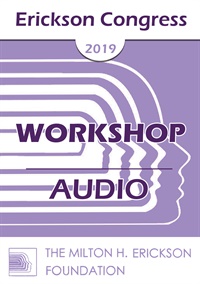
- Average Rating:
- Not yet rated
- Topic Areas:
- Workshops | Trance | Hypnotherapy | Unconscious Processes
- Categories:
- Erickson Congress | Erickson Congress 2019
- Faculty:
- Stephen Gilligan, PhD
- Duration:
- 2 Hours 1 Minutes
- Format:
- Audio Only
- Original Program Date:
- Dec 15, 2019
- Short Description:
- This workshop presents Dr. Gilligan’s latest work of Systemic Trance, which describes how we generate our realities via the (mostly unconscious) maps of who we are, and what the world is. These systemic filters can be held negatively (in neuro-muscular lock) or generatively (in creative flow), resulting in either problems or positive solutions. To transform problems into resources, Systemic Trance first identifies the key parts of a performance map, then uses generative trance to open a fluid conversational space where each part is positive valued and integrated into a resource pattern. Lecture, demonstration, case examples, and exercises will be included.
- Price:
- $15.00 - Base Price
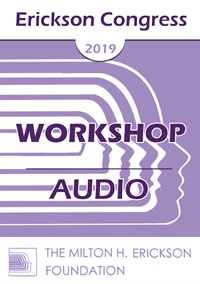
- Average Rating:
- Not yet rated
- Topic Areas:
- Workshops | Anxiety | Milton Erickson | Virginia Satir | Somatic Experiences | Hypnotherapy | Resources
- Categories:
- Erickson Congress | Erickson Congress 2019
- Faculty:
- Wei-Kai Hung, M.Ed., L.M.H.C., L.P.C. | Eva Wieprecht, MBA
- Duration:
- 1 Hour 58 Minutes
- Format:
- Audio Only
- Original Program Date:
- Dec 15, 2019
- Short Description:
- In this workshop, East and West blend, intertwine, and approach anxiety symptoms in a creative way. Eva from Germany, with her masterful practice in Satir somatic modeling, combined with Wei Kai from Taiwan, with his mindful practice in Tai Chi and Taoism hypnotherapy, will create a new model in treating anxiety. We both learned Ericksonian approach for years, and utilized various somatic movements to help self regulation, and increase self steering competencies in challenging times.
- Price:
- $15.00 - Base Price
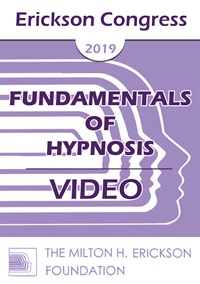
- Average Rating:
- Not yet rated
- Topic Areas:
- Fundamentals of Hypnosis | Hypnosis | Hypnotic Phenomena | Hypnotherapy | Ericksonian Hypnosis and Therapy Techniques
- Categories:
- Erickson Congress | Erickson Congress 2019
- Faculty:
- Dan Short, PhD
- Course Levels:
- Master Degree or Higher in Health-Related Field
- Duration:
- 2 Hours 1 Minutes
- Format:
- Audio and Video
- Original Program Date:
- Dec 15, 2019
- Short Description:
- Erickson resisted standardized hypnotic protocols because he found that everyone responded to hypnosis uniquely. Rather than seeking to force his preferred hypnotic phenomena, he cultivated whatever came naturally. Fortunately, clinical objectives, such as pain relief, can be achieved using a variety of hypnotic phenomena. This session will identify three broad classes of hypnotic experiencing and provide guidance on how to identify natural predispositions.
- Price:
-
Sale is $29.00
price reduced from Base Price - $59.00
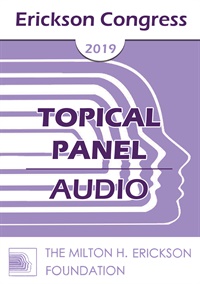
- Average Rating:
- Not yet rated
- Topic Areas:
- Workshops | Ericksonian Hypnosis and Therapy Techniques | Hypnosis | Hypnotherapy | Post-Traumatic Stress Disorder (PTSD)
- Categories:
- Erickson Congress | Erickson Congress 2019
- Faculty:
- Jorge Abia, MD
- Duration:
- 2 Hours
- Format:
- Audio Only
- Original Program Date:
- Dec 13, 2019
- Short Description:
- Immediately after earthquakes in center and southern Mexico in 2017, crisis intervention were done by Mexican navy health care professionals to solve crisis and prevent PTSD. Groups of patients were structured for crisis intervention with Ericksonian hypnotherapy, ranging from 50 to 200 patients. Methodology will be presented along with recorded interviews to two captains head of Mexican navy health care system. One powerful proven group technique will be taught.
- Price:
- $15.00 - Base Price
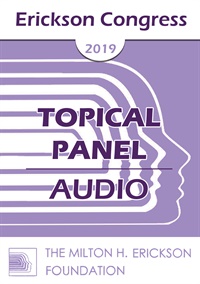
- Average Rating:
- Not yet rated
- Topic Areas:
- Workshops | Hypnotherapy | Mind-Body | Resistance | Couples Therapy
- Categories:
- Erickson Congress | Erickson Congress 2019
- Faculty:
- Bruce Gregory, PhD | Birgitta Gregory, PhD
- Duration:
- 1 Hour 58 Minutes
- Format:
- Audio Only
- Original Program Date:
- Dec 12, 2019
- Short Description:
- This workshop will explore how the processes and variables of quantum physics can be integrated with mind-body hypnotherapy in the treatment of couples and organizations. The intention of the workshop is to support the expansion of trust within professionals to contain resistance and creatively focus attention, facilitating novelty, rapport, and opportunities for learning. The Erickson Resistance Protocol and Poincare's four stage creative process will be utilized to provide a template to develop internal yes sets for quantum principles, processes and variables. Emphasis will be placed on how the grandiosity and victim subsets of resistance, and the appreciation of intent and accountability are related to the quantum variables of momentum, motion, time, space and position.
- Price:
- $15.00 - Base Price
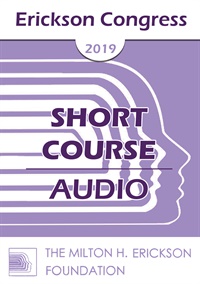
- Average Rating:
- Not yet rated
- Topic Areas:
- Short Courses | Hypnotherapy | Phobia | Hypnosis
- Categories:
- Erickson Congress | Erickson Congress 2019
- Faculty:
- Carlos Ramos, PhD
- Duration:
- 1 Hour 2 Minutes
- Format:
- Audio Only
- Original Program Date:
- Dec 12, 2019
- Short Description:
- The author of this research and presentation will explore how Douglas Flemons, the developer of relational hypnosis, facilitated an enduring non-volitional shift with a client, “Grace,” who desired to have a baby but could not see or talk about blood, needles, or medical procedures without fainting. Using context-enriched conversation analysis (CECA), the author will describe how he embraced his understanding of Ericksonian and Neo-Ericksonian hypnosis methods as a guide to examine multiple sources of data, which included selected audio-recorded excerpts from Douglas and Grace’s hypnotherapeutic sessions; Grace’s descriptions of change in her email correspondence with Douglas; and Douglas’s case notes.
- Price:
- $15.00 - Base Price
Tags: Hypnosis Hypnotherapy Phobias
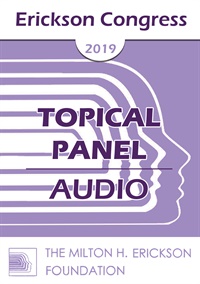
- Average Rating:
- Not yet rated
- Topic Areas:
- Workshops | Ericksonian Hypnosis and Therapy Techniques | Hypnotherapy | Hypnosis | Mind-Body
- Categories:
- Erickson Congress | Erickson Congress 2019
- Faculty:
- Douglas Flemons, PhD
- Duration:
- 1 Hour 54 Minutes
- Format:
- Audio Only
- Original Program Date:
- Dec 12, 2019
- Short Description:
- This workshop will go to the heart of Ericksonian hypnotherapy, in both senses of the word. We’ll use Gregory Bateson’s ideas about mind to illuminate the core or essence of an Ericksonian approach, exploring key principles and signature practices, such as utilization, metaphoric communication, and therapeutic double binds. But we’ll also explore the beating heart of this way of working—the application of empathy, the invitation of trance, and the evocation and facilitation of therapeutic change, all guided by a deep respect for and understanding of the mindfulness of the body and the embodiment of the mind.
- Price:
- $15.00 - Base Price
Please wait ...


